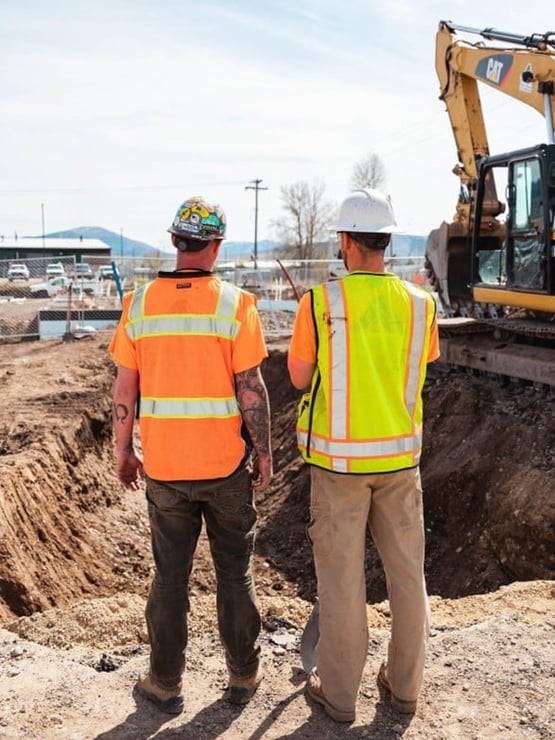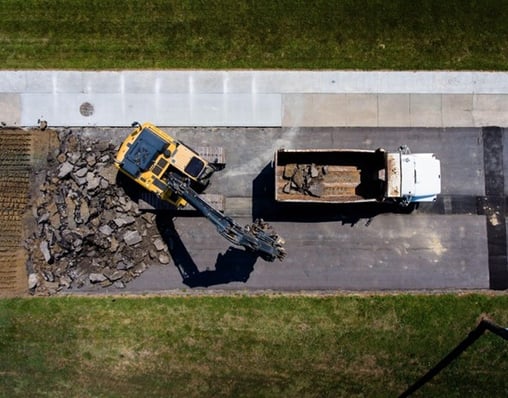
Mastering Construction Bidding in Heavy Construction Projects
A closer look at the construction bidding process
In the competitive heavy construction industry, the way a firm manages the construction bidding process can make or break their business.
Setting a price is just one part of the equation—it also involves thoroughly understanding the scope of the project, accurately estimating costs, and ultimately submitting a bid that is competitive and in line with your company’s capabilities. Making an accurate bid is particularly crucial in complex heavy construction projects, which can cover extensive areas and concern critical infrastructure.
We’ve put together a guide that covers the intricacies of construction bid preparation, from the fundamentals of bidding to utilizing construction bidding software like TCLI’s Estimating Link®. We’ll provide you with actionable insights and strategies to help you bid smarter, improve your productivity, and win more jobs.

Bidding vs. estimating
You might think that ‘construction bidding’ and ‘construction estimating’ are the same thing; however, there’s a clear distinction between the two terms.
Construction estimating is when a contractor forecasts the costs of building a project based on the information at hand. The client can then use this estimate to help them assess the financial feasibility of their project. Making an accurate estimate lays the groundwork for a realistic and competitive bid, but it’s just one part of the overall bidding process.
In contrast, construction bidding is a more definitive and official process. When a contractor submits a bid, they are making a formal offer to execute a project at a specific price. If the client accepts this bid, it then forms a legally binding agreement between the two parties.
A bid typically includes a detailed scope of work, a breakdown of expenses, the projected timeline, and specific terms and conditions, reflecting the contractor’s commitment and understanding of the project’s complexities. By submitting a bid, the contractor is pledging their capability and accountability, as well as demonstrating their readiness to take on the project.
While estimating offers a preliminary cost framework, bidding solidifies this into a formal, binding agreement. Both stages are integral in the construction of a project, representing critical junctions in a project’s lifestyle.
Types of construction bids
To fully understand the bidding process, it is necessary to know the different types of construction bids and the situations in which they are used. When a client is ready to receive bids for a project, they will typically choose from one of the following options.
Open tendering: This is when the bid invitation is made public, allowing any contractor to submit a bid. Due to this method’s transparency and competitiveness, open tendering is the preferred choice for government projects, including those involving heavy construction. The competitive environment often results in a significant number of bids, ensuring a wide range of options for the client; however, this demands considerable time and resources for thorough evaluation.
Negotiated tendering: In this approach, the client enters direct negotiation with a chosen contractor. Negotiated tendering is often utilized when the project requires the contractor to have specialized skills or when the client has a previous working relationship with the contractor. Notably, this method allows for more flexibility in the contract terms and adjustments to the project, which can aid in accelerating the usually long bid negotiation process, in turn allowing the project to be completed faster. On the downside, negotiated tendering can lack the competitiveness of open tendering, potentially leading to higher costs.
Selective tendering: This method strikes a balance between open and negotiated tendering by inviting bids from a pre-selected group of contractors who are chosen based on their experience and past performance. This approach ensures a manageable level of high-quality bids from capable contractors and is particularly beneficial for projects needing specific expertise. A negative aspect of selective tendering is that it could exclude qualified new entrants or smaller contractors who haven't had the opportunity to establish their reputation.
Each of these bidding methods serves a distinct purpose and is tailored to suit different project requirements and client preferences, and selecting the appropriate bid type is key for fulfilling the unique requirements and goals of a project. Understanding how open tendering, negotiated tendering, and selective tendering work ensures that both the contractor and the client can make informed decisions, resulting in a more efficient and effective bidding process.
How to bid on construction jobs in heavy construction
Bidding takes on unique significance when heavy construction is involved. These complex projects often cover vast areas, requiring a different set of planning and execution. Importantly, heavy construction deals with critical infrastructure, making the stakes even higher.
The bidding process starts with bid solicitations, where project owners, often government agencies or large corporations, announce their needs. Contractors must then prepare their submissions, balancing competitiveness with profitability. Accuracy is crucial here, and tools like construction estimating software can significantly aid in the process.
Once the bids are submitted, the client evaluates the proposals on feasibility and cost. Successful bids move to the contract negotiation stage. Here, the finer details of a project are discussed and agreed upon, requiring a balance between the firm’s capabilities and project requirements.
The process culminates with contract signing, formalizing the agreement and setting the project into motion.
Maximize your team's efficiency with construction bidding software
 The adoption of construction bidding software has revolutionized the ways bids are prepared, submitted, and managed. Tools like TCLI’s Estimating Link® have become indispensable for contractors, enabling smarter bidding strategies and greatly improving efficiency.
The adoption of construction bidding software has revolutionized the ways bids are prepared, submitted, and managed. Tools like TCLI’s Estimating Link® have become indispensable for contractors, enabling smarter bidding strategies and greatly improving efficiency.
A standout feature of this software is its user-friendly interface, making it easy to use without lengthy training and allowing your team to quickly utilize its full potential. Additionally, the software’s ability to integrate with numerous systems such as accounting, payroll, and project management makes your workflow efficient, maintaining consistency and continuity throughout the project’s lifecycle.
Every successful construction bid depends on the accuracy of its estimates. Construction bidding software plays a major role in helping you to achieve this, significantly minimizing errors in cost estimations. This software provides automation solutions for complex calculations and can offer real-time material and labor costs, allowing you to make bids that are competitive as well as financially feasible. In turn, you should see an improvement in your win rate and overall profitability.
Plus, putting together a bid requires compiling numerous reports like detailed project plans and compliance requirements. Software simplifies this aspect as it includes a library of pre-designed reports that can be customized to the specific needs of your project, which saves time and reduces the likelihood of errors. Having all of your documents and data organized on a centralized platform also enhances collaboration, enabling everyone on a project to be on the same page. This increases productivity and fosters an efficient, unified approach to bidding.
Another way to improve your bidding success is by understanding your past successes and failures. Through advanced analytics and reporting found in construction bidding software, you can thoroughly analyze your bidding history and identify trends that have previously led to successful bids in the past. With this information, you can approach each new project with a data-driven strategy, enhancing your ability to submit successful bids.
Importantly, this software can handle a diverse range of projects, including in sectors like heavy civil, transportation, utilities, land and site development, energy and resources, and specialty construction. No matter what field you’re in or the size of the jobs you work on, these tools can support you in handling the complexities of your specific niche. In fact, you can bid on any type of job in just a matter of minutes.
In short, construction bidding software is designed to enhance every aspect of the bidding process, thereby enabling you to achieve superior results and expand your business. To discover how TCLI’s software solutions can transform your approach to bidding, we encourage you to explore Estimating Link®.
Parting perspectives for elevating your bidding strategy
To be successful in construction bidding, you need to have a comprehensive understanding of project specifics, the appropriate bid approach, and the complete bidding process. Fortunately, construction bidding software has greatly enhanced the precision, efficiency, and effectiveness of bidding, enabling contractors to better handle the competitive nature of the industry.
With this software, the entire bidding process is simplified. Gone are the days of bulky stacks of paper and managing physical documents. Now, everything is paperless, which not only is sustainable but also enhances accessibility and organization.
Errors that were once commonplace have been eliminated. Construction bidding software prevents you from submitting incomplete or incorrect bids. This feature ensures that every bid submission is accurate and complete, reducing the likelihood of errors that could cost your firm valuable opportunities.
These easy-to-use programs have dramatically changed the construction industry. Now, submitting a bid is as simple as sending an email or using a basic spreadsheet application. This has greatly simplified the process of bidding on multiple projects, allowing contractors to seize more opportunities. As efficiency and agility are key, especially in the heavy and civil construction sector, construction bidding software has become imperative for any contractor wanting to increase their market presence and achieve greater success.
If you’re interested in learning more about construction bidding, the Construction Management Association of America’s Construction Bidding: The Ultimate Guide To Securing More Jobs offers valuable information. This guide is an excellent resource for expanding your knowledge about bidding.
For personalized assistance or to learn how we can support your needs in heavy construction, feel free to reach out to our team at TCLI.
Achieving success in heavy construction bidding extends beyond simply naming a price—it encompasses a thorough understanding of market dynamics, using the appropriate technological tools, and employing strategies that fit the specific goals of your business. In this competitive and constantly evolving industry, the key to success is staying informed and using your knowledge to make winning bids.




